Statistics For Management Sample Assignment PDF
VerifiedAdded on 2021/01/03
|21
|4631
|478
AI Summary
Contribute Materials
Your contribution can guide someone’s learning journey. Share your
documents today.
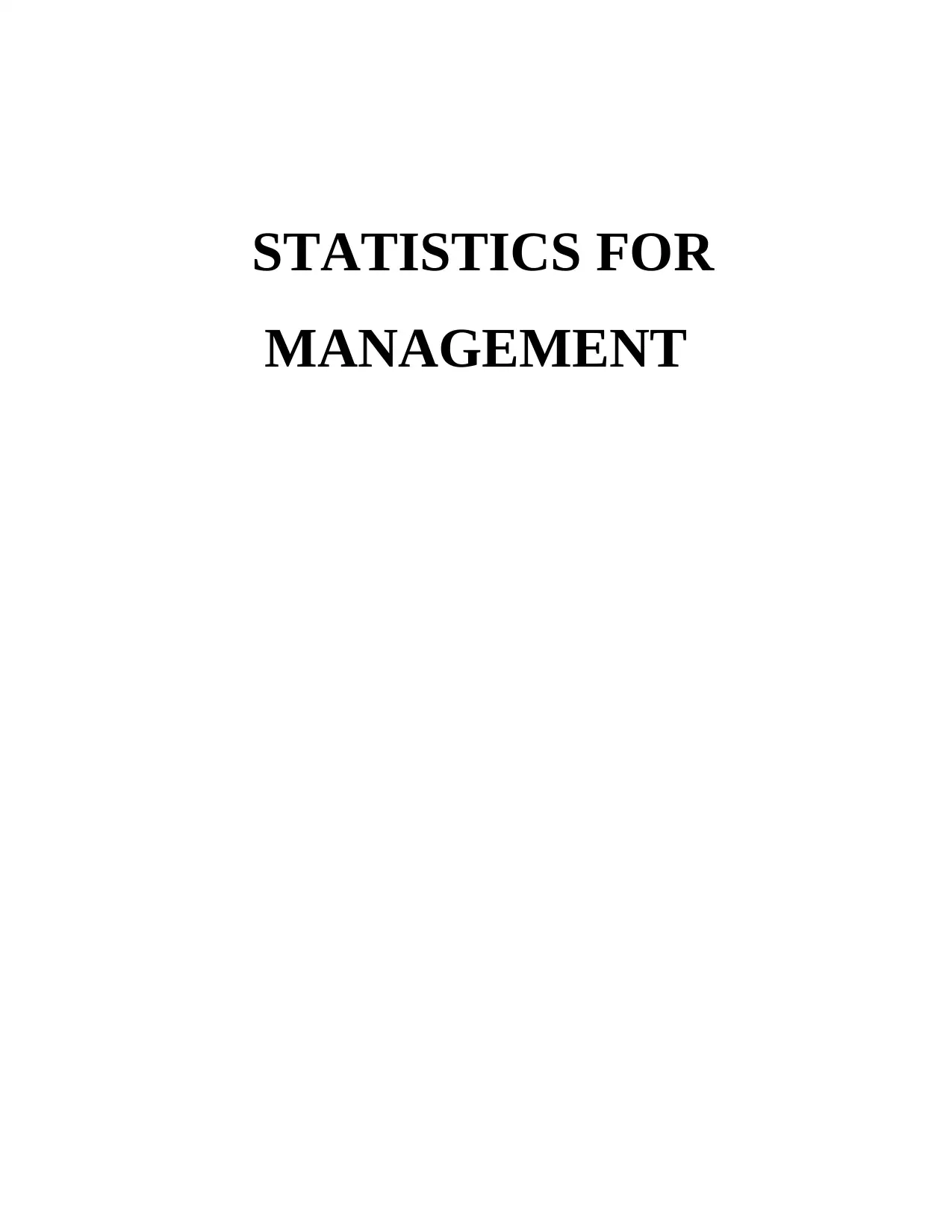
STATISTICS FOR
MANAGEMENT
MANAGEMENT
Secure Best Marks with AI Grader
Need help grading? Try our AI Grader for instant feedback on your assignments.
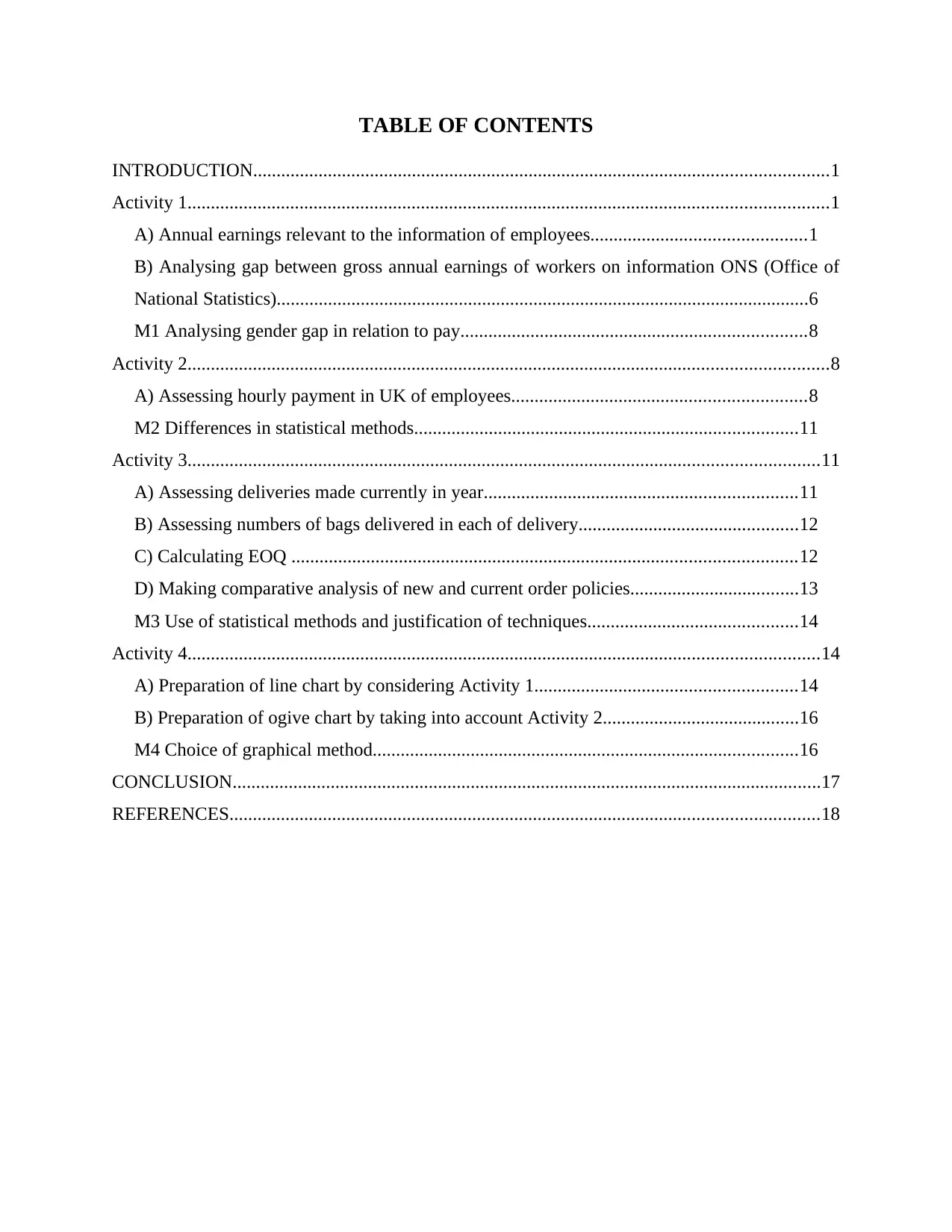
TABLE OF CONTENTS
INTRODUCTION...........................................................................................................................1
Activity 1.........................................................................................................................................1
A) Annual earnings relevant to the information of employees..............................................1
B) Analysing gap between gross annual earnings of workers on information ONS (Office of
National Statistics)..................................................................................................................6
M1 Analysing gender gap in relation to pay..........................................................................8
Activity 2.........................................................................................................................................8
A) Assessing hourly payment in UK of employees...............................................................8
M2 Differences in statistical methods..................................................................................11
Activity 3.......................................................................................................................................11
A) Assessing deliveries made currently in year...................................................................11
B) Assessing numbers of bags delivered in each of delivery...............................................12
C) Calculating EOQ ............................................................................................................12
D) Making comparative analysis of new and current order policies....................................13
M3 Use of statistical methods and justification of techniques.............................................14
Activity 4.......................................................................................................................................14
A) Preparation of line chart by considering Activity 1........................................................14
B) Preparation of ogive chart by taking into account Activity 2..........................................16
M4 Choice of graphical method...........................................................................................16
CONCLUSION..............................................................................................................................17
REFERENCES..............................................................................................................................18
INTRODUCTION...........................................................................................................................1
Activity 1.........................................................................................................................................1
A) Annual earnings relevant to the information of employees..............................................1
B) Analysing gap between gross annual earnings of workers on information ONS (Office of
National Statistics)..................................................................................................................6
M1 Analysing gender gap in relation to pay..........................................................................8
Activity 2.........................................................................................................................................8
A) Assessing hourly payment in UK of employees...............................................................8
M2 Differences in statistical methods..................................................................................11
Activity 3.......................................................................................................................................11
A) Assessing deliveries made currently in year...................................................................11
B) Assessing numbers of bags delivered in each of delivery...............................................12
C) Calculating EOQ ............................................................................................................12
D) Making comparative analysis of new and current order policies....................................13
M3 Use of statistical methods and justification of techniques.............................................14
Activity 4.......................................................................................................................................14
A) Preparation of line chart by considering Activity 1........................................................14
B) Preparation of ogive chart by taking into account Activity 2..........................................16
M4 Choice of graphical method...........................................................................................16
CONCLUSION..............................................................................................................................17
REFERENCES..............................................................................................................................18
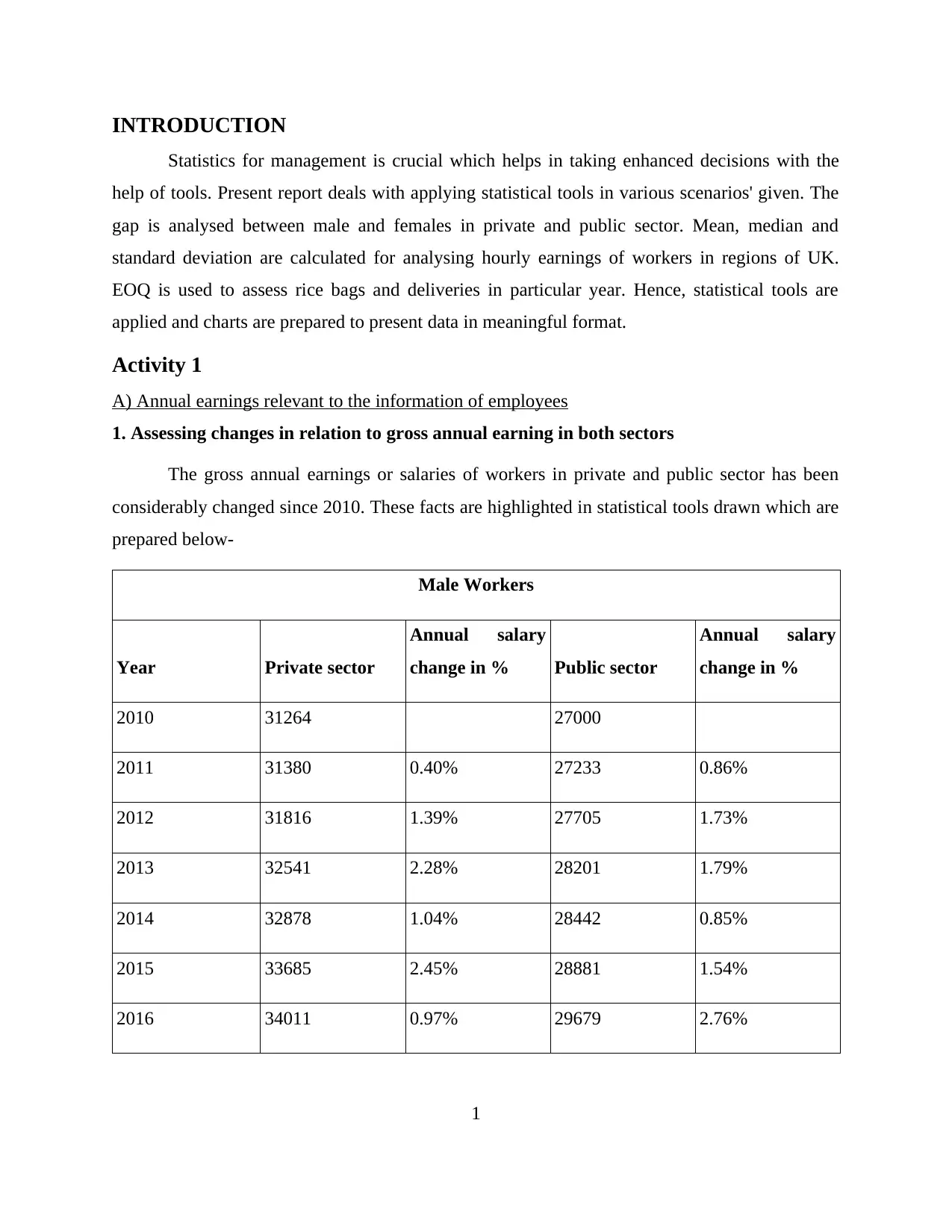
INTRODUCTION
Statistics for management is crucial which helps in taking enhanced decisions with the
help of tools. Present report deals with applying statistical tools in various scenarios' given. The
gap is analysed between male and females in private and public sector. Mean, median and
standard deviation are calculated for analysing hourly earnings of workers in regions of UK.
EOQ is used to assess rice bags and deliveries in particular year. Hence, statistical tools are
applied and charts are prepared to present data in meaningful format.
Activity 1
A) Annual earnings relevant to the information of employees
1. Assessing changes in relation to gross annual earning in both sectors
The gross annual earnings or salaries of workers in private and public sector has been
considerably changed since 2010. These facts are highlighted in statistical tools drawn which are
prepared below-
Male Workers
Year Private sector
Annual salary
change in % Public sector
Annual salary
change in %
2010 31264 27000
2011 31380 0.40% 27233 0.86%
2012 31816 1.39% 27705 1.73%
2013 32541 2.28% 28201 1.79%
2014 32878 1.04% 28442 0.85%
2015 33685 2.45% 28881 1.54%
2016 34011 0.97% 29679 2.76%
1
Statistics for management is crucial which helps in taking enhanced decisions with the
help of tools. Present report deals with applying statistical tools in various scenarios' given. The
gap is analysed between male and females in private and public sector. Mean, median and
standard deviation are calculated for analysing hourly earnings of workers in regions of UK.
EOQ is used to assess rice bags and deliveries in particular year. Hence, statistical tools are
applied and charts are prepared to present data in meaningful format.
Activity 1
A) Annual earnings relevant to the information of employees
1. Assessing changes in relation to gross annual earning in both sectors
The gross annual earnings or salaries of workers in private and public sector has been
considerably changed since 2010. These facts are highlighted in statistical tools drawn which are
prepared below-
Male Workers
Year Private sector
Annual salary
change in % Public sector
Annual salary
change in %
2010 31264 27000
2011 31380 0.40% 27233 0.86%
2012 31816 1.39% 27705 1.73%
2013 32541 2.28% 28201 1.79%
2014 32878 1.04% 28442 0.85%
2015 33685 2.45% 28881 1.54%
2016 34011 0.97% 29679 2.76%
1
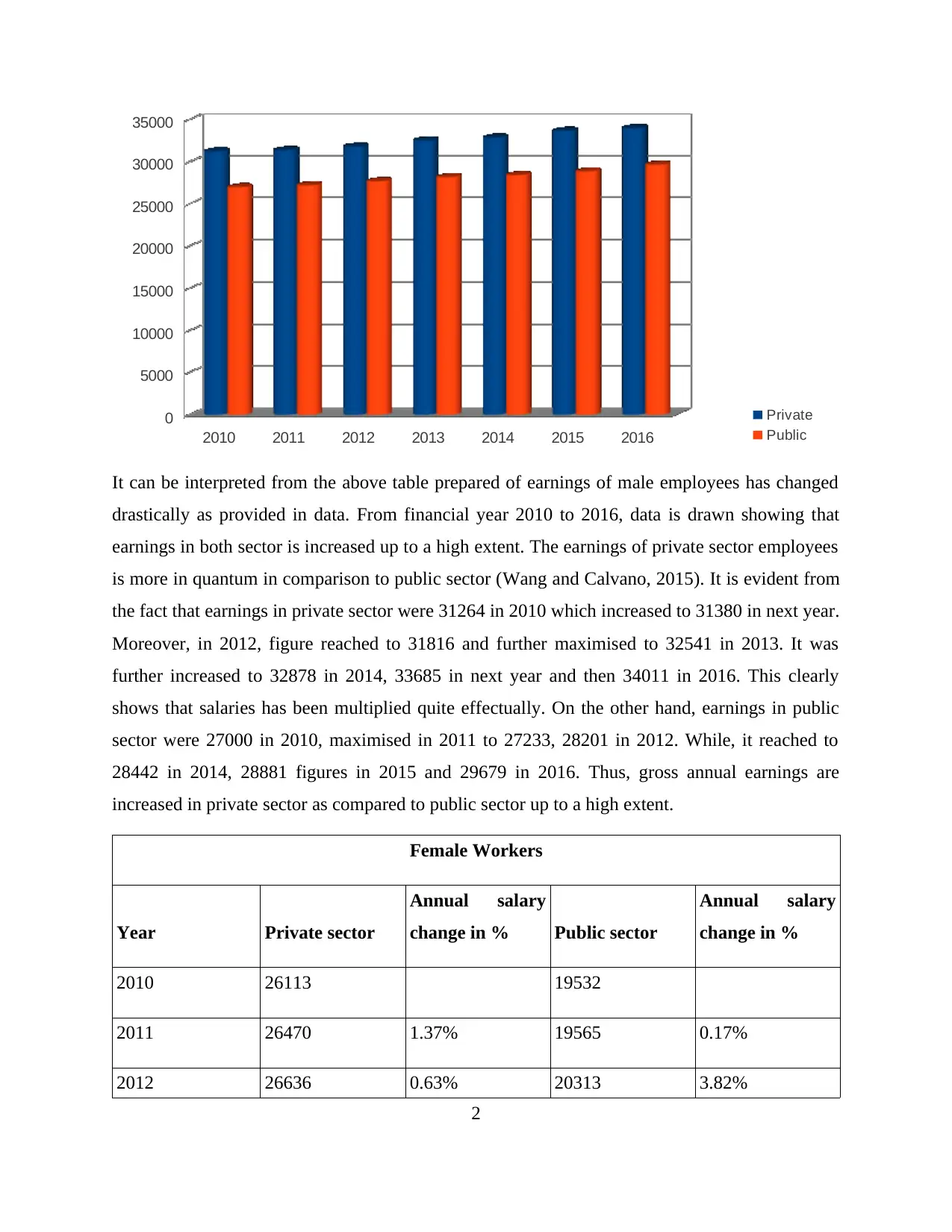
2010 2011 2012 2013 2014 2015 2016
0
5000
10000
15000
20000
25000
30000
35000
Private
Public
It can be interpreted from the above table prepared of earnings of male employees has changed
drastically as provided in data. From financial year 2010 to 2016, data is drawn showing that
earnings in both sector is increased up to a high extent. The earnings of private sector employees
is more in quantum in comparison to public sector (Wang and Calvano, 2015). It is evident from
the fact that earnings in private sector were 31264 in 2010 which increased to 31380 in next year.
Moreover, in 2012, figure reached to 31816 and further maximised to 32541 in 2013. It was
further increased to 32878 in 2014, 33685 in next year and then 34011 in 2016. This clearly
shows that salaries has been multiplied quite effectually. On the other hand, earnings in public
sector were 27000 in 2010, maximised in 2011 to 27233, 28201 in 2012. While, it reached to
28442 in 2014, 28881 figures in 2015 and 29679 in 2016. Thus, gross annual earnings are
increased in private sector as compared to public sector up to a high extent.
Female Workers
Year Private sector
Annual salary
change in % Public sector
Annual salary
change in %
2010 26113 19532
2011 26470 1.37% 19565 0.17%
2012 26636 0.63% 20313 3.82%
2
0
5000
10000
15000
20000
25000
30000
35000
Private
Public
It can be interpreted from the above table prepared of earnings of male employees has changed
drastically as provided in data. From financial year 2010 to 2016, data is drawn showing that
earnings in both sector is increased up to a high extent. The earnings of private sector employees
is more in quantum in comparison to public sector (Wang and Calvano, 2015). It is evident from
the fact that earnings in private sector were 31264 in 2010 which increased to 31380 in next year.
Moreover, in 2012, figure reached to 31816 and further maximised to 32541 in 2013. It was
further increased to 32878 in 2014, 33685 in next year and then 34011 in 2016. This clearly
shows that salaries has been multiplied quite effectually. On the other hand, earnings in public
sector were 27000 in 2010, maximised in 2011 to 27233, 28201 in 2012. While, it reached to
28442 in 2014, 28881 figures in 2015 and 29679 in 2016. Thus, gross annual earnings are
increased in private sector as compared to public sector up to a high extent.
Female Workers
Year Private sector
Annual salary
change in % Public sector
Annual salary
change in %
2010 26113 19532
2011 26470 1.37% 19565 0.17%
2012 26636 0.63% 20313 3.82%
2
Secure Best Marks with AI Grader
Need help grading? Try our AI Grader for instant feedback on your assignments.
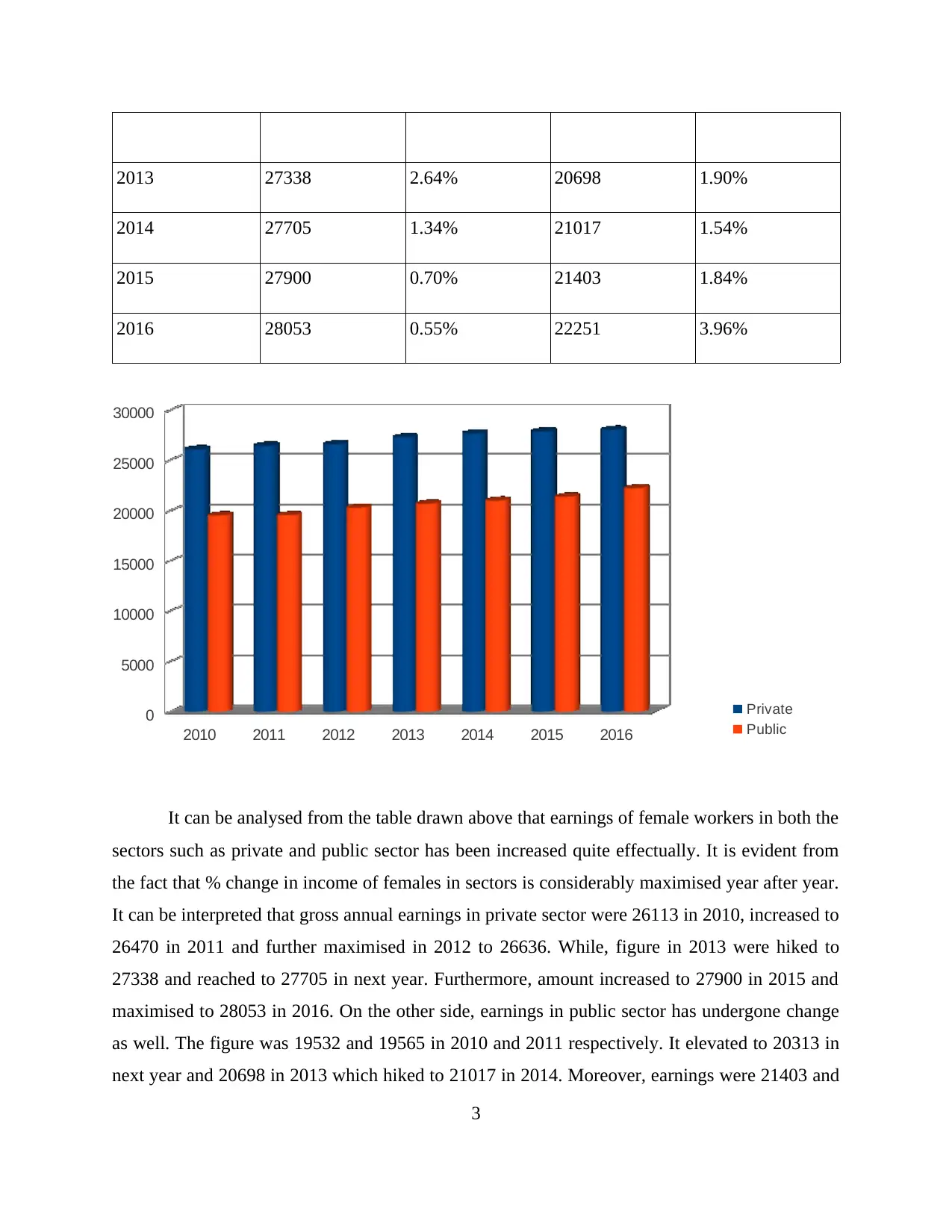
2013 27338 2.64% 20698 1.90%
2014 27705 1.34% 21017 1.54%
2015 27900 0.70% 21403 1.84%
2016 28053 0.55% 22251 3.96%
2010 2011 2012 2013 2014 2015 2016
0
5000
10000
15000
20000
25000
30000
Private
Public
It can be analysed from the table drawn above that earnings of female workers in both the
sectors such as private and public sector has been increased quite effectually. It is evident from
the fact that % change in income of females in sectors is considerably maximised year after year.
It can be interpreted that gross annual earnings in private sector were 26113 in 2010, increased to
26470 in 2011 and further maximised in 2012 to 26636. While, figure in 2013 were hiked to
27338 and reached to 27705 in next year. Furthermore, amount increased to 27900 in 2015 and
maximised to 28053 in 2016. On the other side, earnings in public sector has undergone change
as well. The figure was 19532 and 19565 in 2010 and 2011 respectively. It elevated to 20313 in
next year and 20698 in 2013 which hiked to 21017 in 2014. Moreover, earnings were 21403 and
3
2014 27705 1.34% 21017 1.54%
2015 27900 0.70% 21403 1.84%
2016 28053 0.55% 22251 3.96%
2010 2011 2012 2013 2014 2015 2016
0
5000
10000
15000
20000
25000
30000
Private
Public
It can be analysed from the table drawn above that earnings of female workers in both the
sectors such as private and public sector has been increased quite effectually. It is evident from
the fact that % change in income of females in sectors is considerably maximised year after year.
It can be interpreted that gross annual earnings in private sector were 26113 in 2010, increased to
26470 in 2011 and further maximised in 2012 to 26636. While, figure in 2013 were hiked to
27338 and reached to 27705 in next year. Furthermore, amount increased to 27900 in 2015 and
maximised to 28053 in 2016. On the other side, earnings in public sector has undergone change
as well. The figure was 19532 and 19565 in 2010 and 2011 respectively. It elevated to 20313 in
next year and 20698 in 2013 which hiked to 21017 in 2014. Moreover, earnings were 21403 and
3
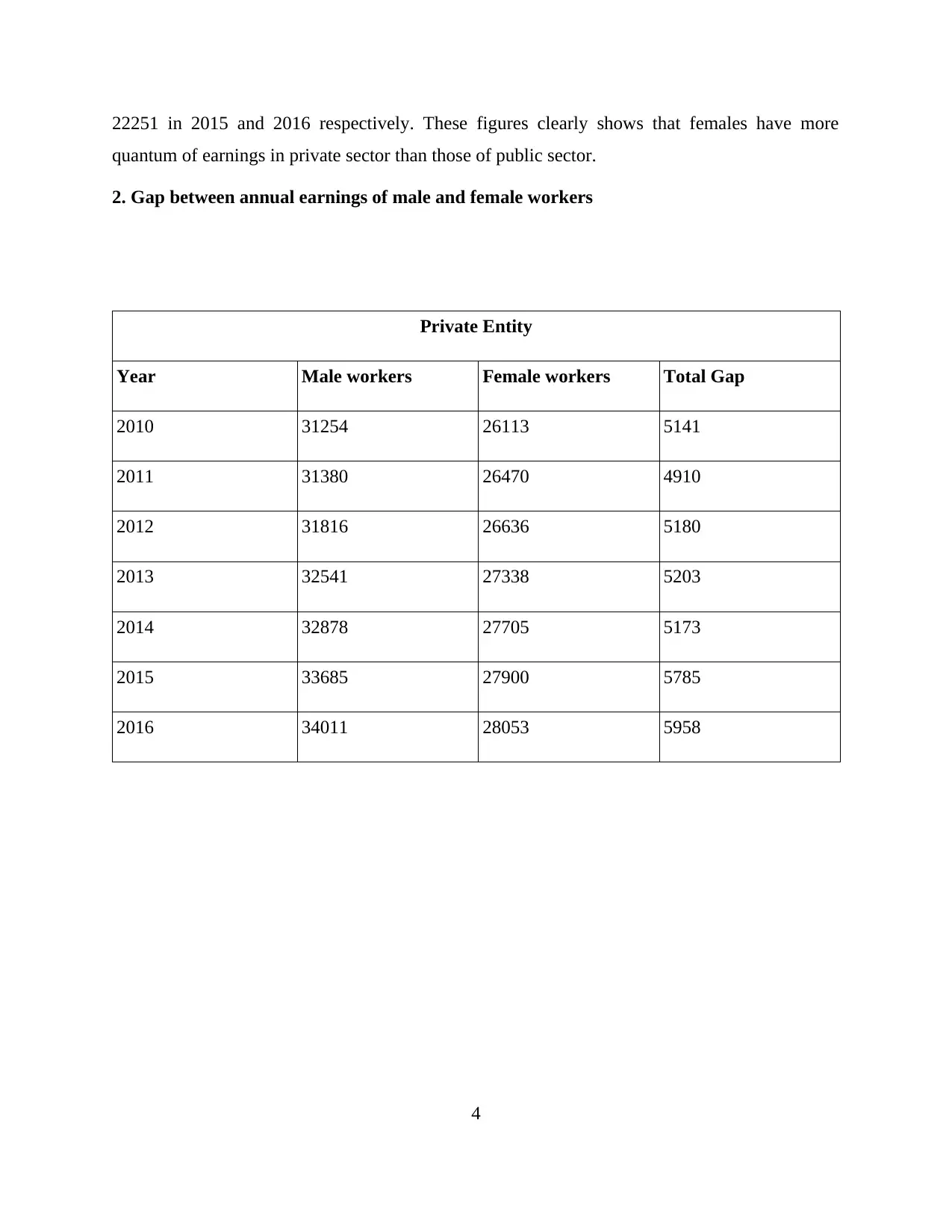
22251 in 2015 and 2016 respectively. These figures clearly shows that females have more
quantum of earnings in private sector than those of public sector.
2. Gap between annual earnings of male and female workers
Private Entity
Year Male workers Female workers Total Gap
2010 31254 26113 5141
2011 31380 26470 4910
2012 31816 26636 5180
2013 32541 27338 5203
2014 32878 27705 5173
2015 33685 27900 5785
2016 34011 28053 5958
4
quantum of earnings in private sector than those of public sector.
2. Gap between annual earnings of male and female workers
Private Entity
Year Male workers Female workers Total Gap
2010 31254 26113 5141
2011 31380 26470 4910
2012 31816 26636 5180
2013 32541 27338 5203
2014 32878 27705 5173
2015 33685 27900 5785
2016 34011 28053 5958
4

2010 2011 2012 2013 2014 2015 2016
0
1000
2000
3000
4000
5000
6000
The above table shows total gap observed in male and female workforces in private
entity. It can be analysed from table that earnings of male employees are more in comparison to
that with females in the same sector. The figures are considerably increased of males and females
in the period starting from 2010 to 2016. Total gap can be easily recognised as it was 5141 in
2010, decreased to 4910 in 2011. While, it reached to 5180 in next period and then maximised to
5203 in 2013 and then to 5173 in 2014. The figure was 5785 in 2015 and 5958 in 2016 which
shows that productivity of total workforces has been elevated up to a high extent. This clearly
implies both male and female are performing in accordance to the standards set and helping UK
in accelerating overall growth in the best possible manner. The capacity of workforce
considering female and male employees is hiked in case of private sector.
Public Entity
Year Male workers Female workers Total Gap
2010 27000 19532 7468
2011 27233 19565 7668
5
0
1000
2000
3000
4000
5000
6000
The above table shows total gap observed in male and female workforces in private
entity. It can be analysed from table that earnings of male employees are more in comparison to
that with females in the same sector. The figures are considerably increased of males and females
in the period starting from 2010 to 2016. Total gap can be easily recognised as it was 5141 in
2010, decreased to 4910 in 2011. While, it reached to 5180 in next period and then maximised to
5203 in 2013 and then to 5173 in 2014. The figure was 5785 in 2015 and 5958 in 2016 which
shows that productivity of total workforces has been elevated up to a high extent. This clearly
implies both male and female are performing in accordance to the standards set and helping UK
in accelerating overall growth in the best possible manner. The capacity of workforce
considering female and male employees is hiked in case of private sector.
Public Entity
Year Male workers Female workers Total Gap
2010 27000 19532 7468
2011 27233 19565 7668
5
Paraphrase This Document
Need a fresh take? Get an instant paraphrase of this document with our AI Paraphraser
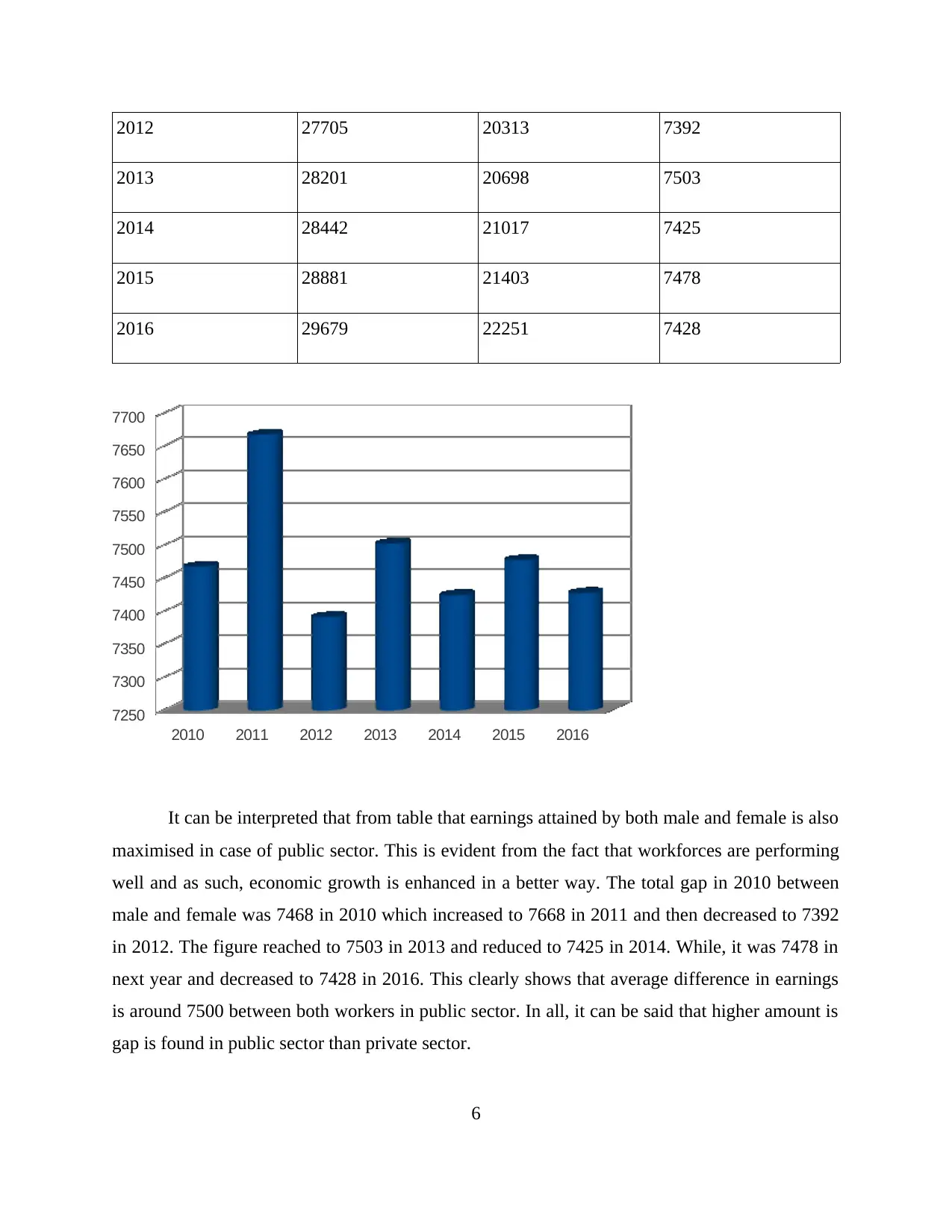
2012 27705 20313 7392
2013 28201 20698 7503
2014 28442 21017 7425
2015 28881 21403 7478
2016 29679 22251 7428
2010 2011 2012 2013 2014 2015 2016
7250
7300
7350
7400
7450
7500
7550
7600
7650
7700
It can be interpreted that from table that earnings attained by both male and female is also
maximised in case of public sector. This is evident from the fact that workforces are performing
well and as such, economic growth is enhanced in a better way. The total gap in 2010 between
male and female was 7468 in 2010 which increased to 7668 in 2011 and then decreased to 7392
in 2012. The figure reached to 7503 in 2013 and reduced to 7425 in 2014. While, it was 7478 in
next year and decreased to 7428 in 2016. This clearly shows that average difference in earnings
is around 7500 between both workers in public sector. In all, it can be said that higher amount is
gap is found in public sector than private sector.
6
2013 28201 20698 7503
2014 28442 21017 7425
2015 28881 21403 7478
2016 29679 22251 7428
2010 2011 2012 2013 2014 2015 2016
7250
7300
7350
7400
7450
7500
7550
7600
7650
7700
It can be interpreted that from table that earnings attained by both male and female is also
maximised in case of public sector. This is evident from the fact that workforces are performing
well and as such, economic growth is enhanced in a better way. The total gap in 2010 between
male and female was 7468 in 2010 which increased to 7668 in 2011 and then decreased to 7392
in 2012. The figure reached to 7503 in 2013 and reduced to 7425 in 2014. While, it was 7478 in
next year and decreased to 7428 in 2016. This clearly shows that average difference in earnings
is around 7500 between both workers in public sector. In all, it can be said that higher amount is
gap is found in public sector than private sector.
6
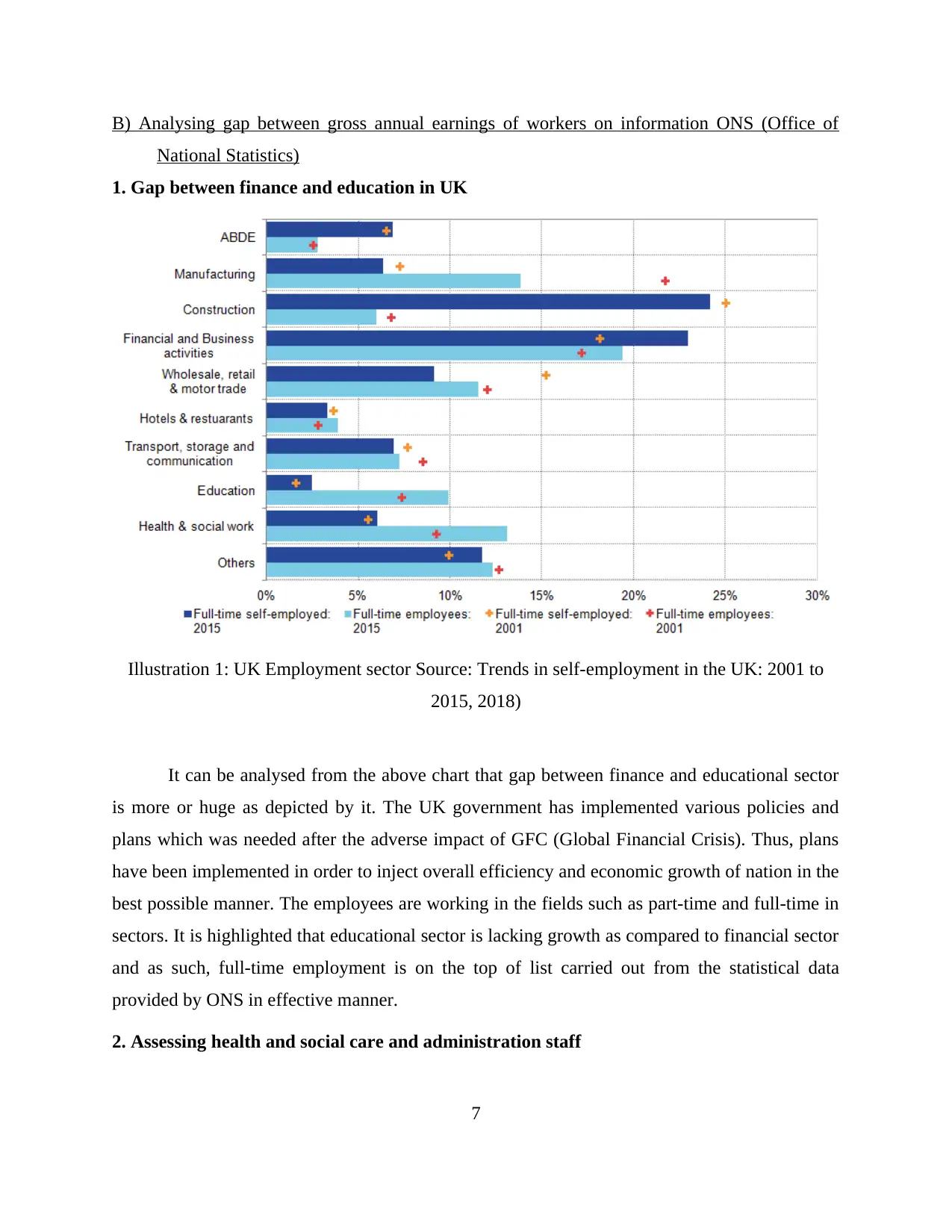
B) Analysing gap between gross annual earnings of workers on information ONS (Office of
National Statistics)
1. Gap between finance and education in UK
Illustration 1: UK Employment sector Source: Trends in self-employment in the UK: 2001 to
2015, 2018)
It can be analysed from the above chart that gap between finance and educational sector
is more or huge as depicted by it. The UK government has implemented various policies and
plans which was needed after the adverse impact of GFC (Global Financial Crisis). Thus, plans
have been implemented in order to inject overall efficiency and economic growth of nation in the
best possible manner. The employees are working in the fields such as part-time and full-time in
sectors. It is highlighted that educational sector is lacking growth as compared to financial sector
and as such, full-time employment is on the top of list carried out from the statistical data
provided by ONS in effective manner.
2. Assessing health and social care and administration staff
7
National Statistics)
1. Gap between finance and education in UK
Illustration 1: UK Employment sector Source: Trends in self-employment in the UK: 2001 to
2015, 2018)
It can be analysed from the above chart that gap between finance and educational sector
is more or huge as depicted by it. The UK government has implemented various policies and
plans which was needed after the adverse impact of GFC (Global Financial Crisis). Thus, plans
have been implemented in order to inject overall efficiency and economic growth of nation in the
best possible manner. The employees are working in the fields such as part-time and full-time in
sectors. It is highlighted that educational sector is lacking growth as compared to financial sector
and as such, full-time employment is on the top of list carried out from the statistical data
provided by ONS in effective manner.
2. Assessing health and social care and administration staff
7

Illustration 2: UK health and social care Source: UK Health Accounts: 2016, 2018)
The chart has been drawn for effectively evaluating health and social care department and
administrative unit in effectual way. This is essentially required to be taken into account so that
efficiency in operational tasks of both the departments can be assessed in a better manner. The
graph shows that more quantum in relation to growth is seen in long-term health care services.
This means government of UK is planning to improve services provided by the department so
that patients could be provided with effective and quality amenities by which they can be treated
with ease. It will be beneficial for health care department as revenue would be maximised in
effective manner. Eventually, it will be helpful for the nation in accelerating growth.
M1 Analysing gender gap in relation to pay
The gap analysed in paying salary to male and female is termed as gender pay gap. It is
analysed that female are paid less in comparison to men. The sources which provides relevant
data is National Magazine, ONS, media and journals etc. These types of sources are used in
8
The chart has been drawn for effectively evaluating health and social care department and
administrative unit in effectual way. This is essentially required to be taken into account so that
efficiency in operational tasks of both the departments can be assessed in a better manner. The
graph shows that more quantum in relation to growth is seen in long-term health care services.
This means government of UK is planning to improve services provided by the department so
that patients could be provided with effective and quality amenities by which they can be treated
with ease. It will be beneficial for health care department as revenue would be maximised in
effective manner. Eventually, it will be helpful for the nation in accelerating growth.
M1 Analysing gender gap in relation to pay
The gap analysed in paying salary to male and female is termed as gender pay gap. It is
analysed that female are paid less in comparison to men. The sources which provides relevant
data is National Magazine, ONS, media and journals etc. These types of sources are used in
8
Secure Best Marks with AI Grader
Need help grading? Try our AI Grader for instant feedback on your assignments.
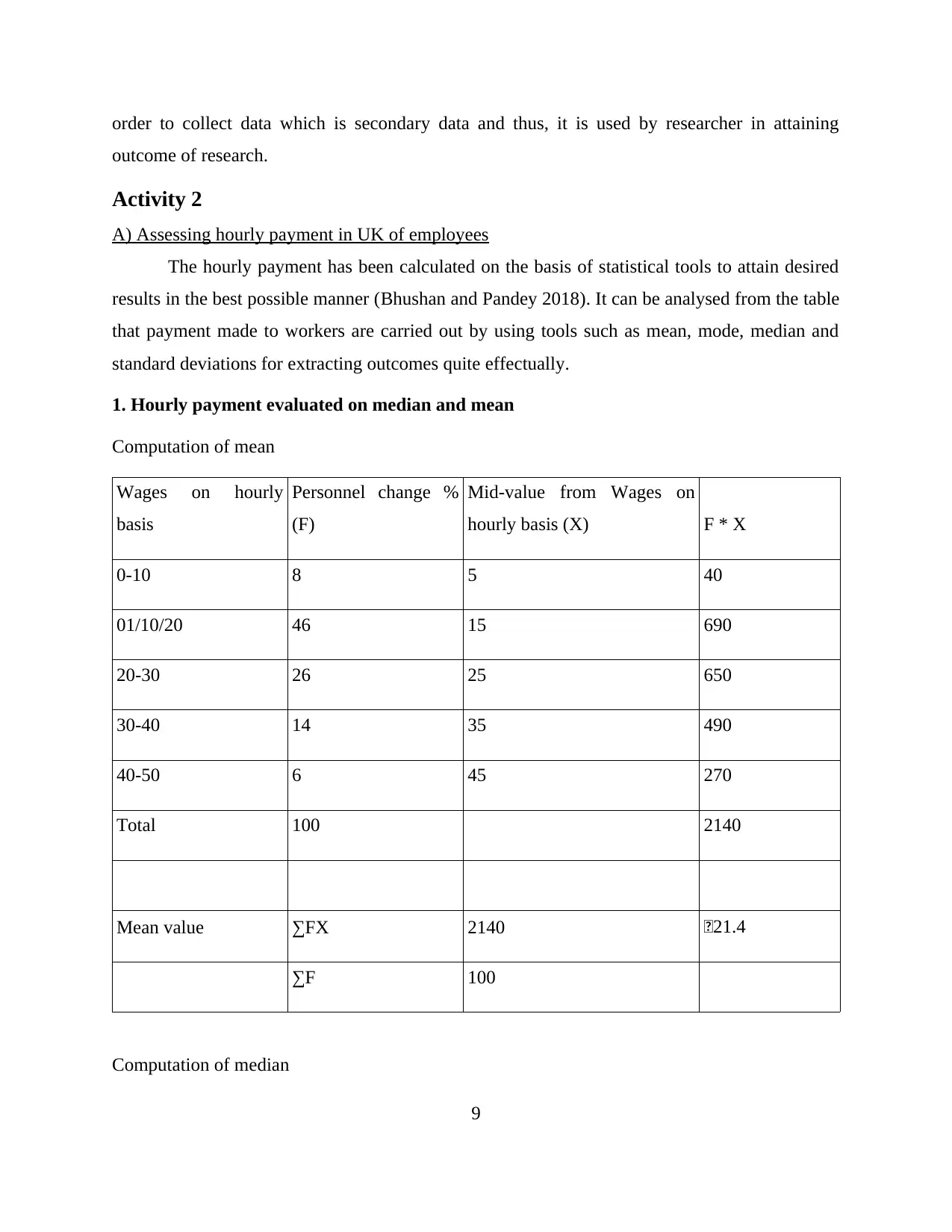
order to collect data which is secondary data and thus, it is used by researcher in attaining
outcome of research.
Activity 2
A) Assessing hourly payment in UK of employees
The hourly payment has been calculated on the basis of statistical tools to attain desired
results in the best possible manner (Bhushan and Pandey 2018). It can be analysed from the table
that payment made to workers are carried out by using tools such as mean, mode, median and
standard deviations for extracting outcomes quite effectually.
1. Hourly payment evaluated on median and mean
Computation of mean
Wages on hourly
basis
Personnel change %
(F)
Mid-value from Wages on
hourly basis (X) F * X
0-10 8 5 40
01/10/20 46 15 690
20-30 26 25 650
30-40 14 35 490
40-50 6 45 270
Total 100 2140
Mean value ∑FX 2140 £21.4
∑F 100
Computation of median
9
outcome of research.
Activity 2
A) Assessing hourly payment in UK of employees
The hourly payment has been calculated on the basis of statistical tools to attain desired
results in the best possible manner (Bhushan and Pandey 2018). It can be analysed from the table
that payment made to workers are carried out by using tools such as mean, mode, median and
standard deviations for extracting outcomes quite effectually.
1. Hourly payment evaluated on median and mean
Computation of mean
Wages on hourly
basis
Personnel change %
(F)
Mid-value from Wages on
hourly basis (X) F * X
0-10 8 5 40
01/10/20 46 15 690
20-30 26 25 650
30-40 14 35 490
40-50 6 45 270
Total 100 2140
Mean value ∑FX 2140 £21.4
∑F 100
Computation of median
9
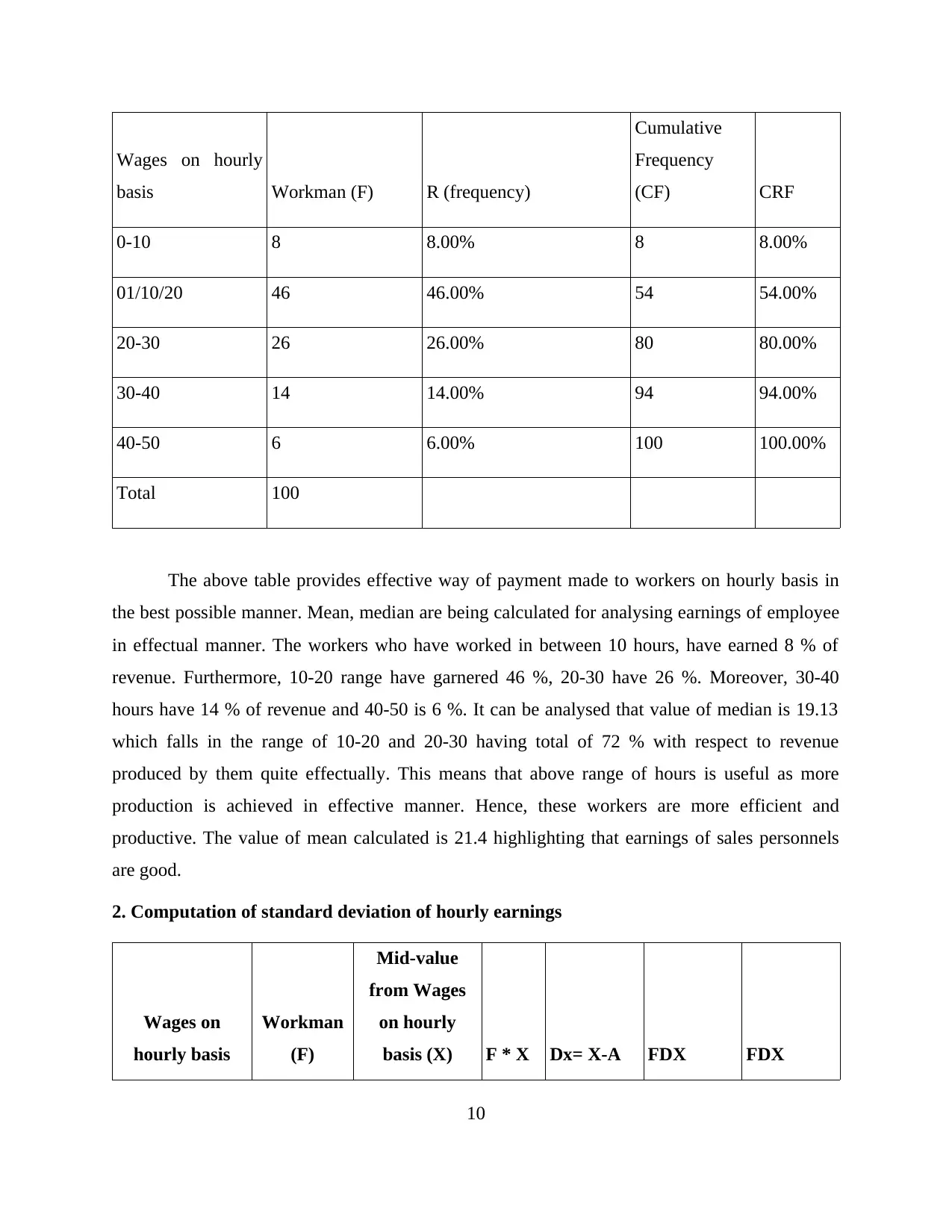
Wages on hourly
basis Workman (F) R (frequency)
Cumulative
Frequency
(CF) CRF
0-10 8 8.00% 8 8.00%
01/10/20 46 46.00% 54 54.00%
20-30 26 26.00% 80 80.00%
30-40 14 14.00% 94 94.00%
40-50 6 6.00% 100 100.00%
Total 100
The above table provides effective way of payment made to workers on hourly basis in
the best possible manner. Mean, median are being calculated for analysing earnings of employee
in effectual manner. The workers who have worked in between 10 hours, have earned 8 % of
revenue. Furthermore, 10-20 range have garnered 46 %, 20-30 have 26 %. Moreover, 30-40
hours have 14 % of revenue and 40-50 is 6 %. It can be analysed that value of median is 19.13
which falls in the range of 10-20 and 20-30 having total of 72 % with respect to revenue
produced by them quite effectually. This means that above range of hours is useful as more
production is achieved in effective manner. Hence, these workers are more efficient and
productive. The value of mean calculated is 21.4 highlighting that earnings of sales personnels
are good.
2. Computation of standard deviation of hourly earnings
Wages on
hourly basis
Workman
(F)
Mid-value
from Wages
on hourly
basis (X) F * X Dx= X-A FDX FDX
10
basis Workman (F) R (frequency)
Cumulative
Frequency
(CF) CRF
0-10 8 8.00% 8 8.00%
01/10/20 46 46.00% 54 54.00%
20-30 26 26.00% 80 80.00%
30-40 14 14.00% 94 94.00%
40-50 6 6.00% 100 100.00%
Total 100
The above table provides effective way of payment made to workers on hourly basis in
the best possible manner. Mean, median are being calculated for analysing earnings of employee
in effectual manner. The workers who have worked in between 10 hours, have earned 8 % of
revenue. Furthermore, 10-20 range have garnered 46 %, 20-30 have 26 %. Moreover, 30-40
hours have 14 % of revenue and 40-50 is 6 %. It can be analysed that value of median is 19.13
which falls in the range of 10-20 and 20-30 having total of 72 % with respect to revenue
produced by them quite effectually. This means that above range of hours is useful as more
production is achieved in effective manner. Hence, these workers are more efficient and
productive. The value of mean calculated is 21.4 highlighting that earnings of sales personnels
are good.
2. Computation of standard deviation of hourly earnings
Wages on
hourly basis
Workman
(F)
Mid-value
from Wages
on hourly
basis (X) F * X Dx= X-A FDX FDX
10
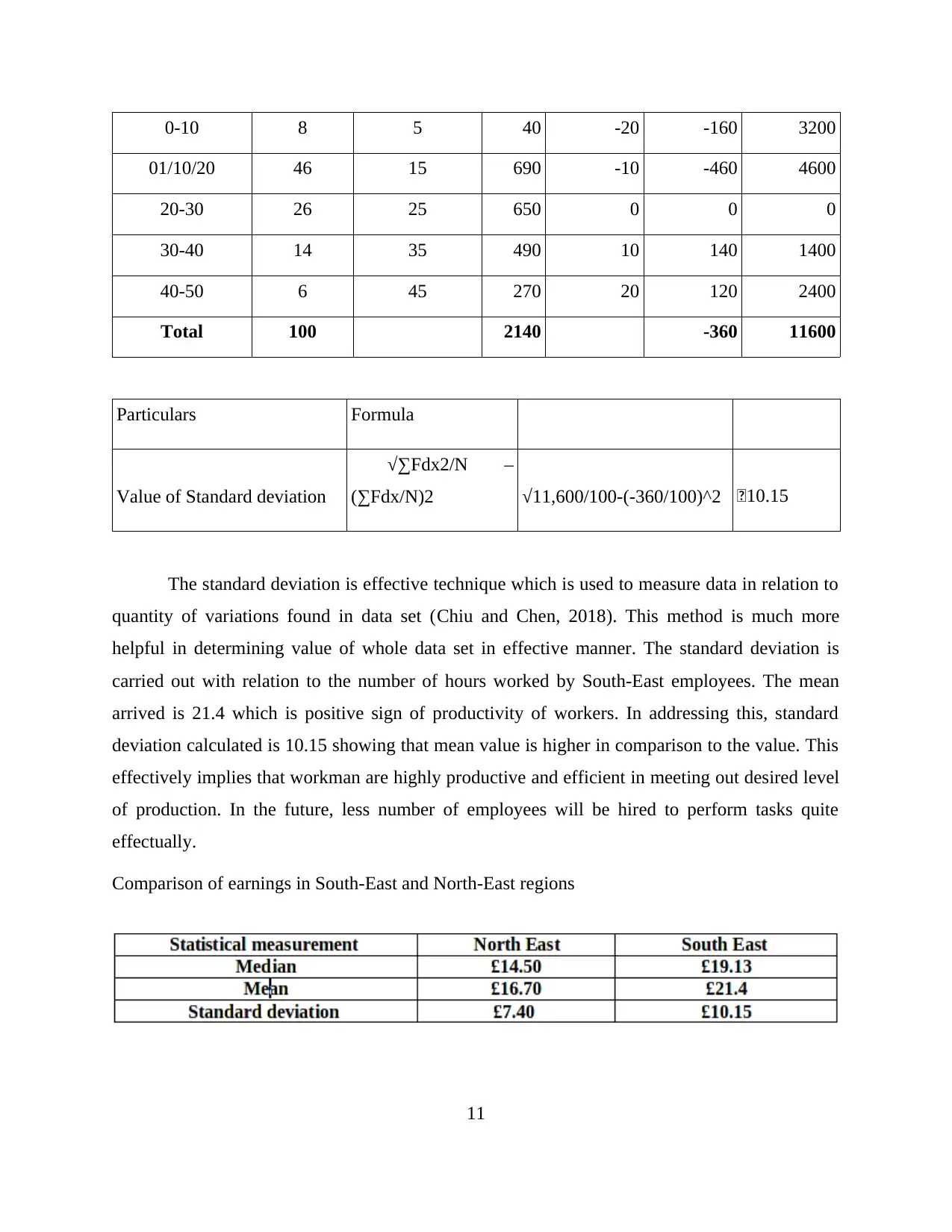
0-10 8 5 40 -20 -160 3200
01/10/20 46 15 690 -10 -460 4600
20-30 26 25 650 0 0 0
30-40 14 35 490 10 140 1400
40-50 6 45 270 20 120 2400
Total 100 2140 -360 11600
Particulars Formula
Value of Standard deviation
√∑Fdx2/N –
(∑Fdx/N)2 √11,600/100-(-360/100)^2 £10.15
The standard deviation is effective technique which is used to measure data in relation to
quantity of variations found in data set (Chiu and Chen, 2018). This method is much more
helpful in determining value of whole data set in effective manner. The standard deviation is
carried out with relation to the number of hours worked by South-East employees. The mean
arrived is 21.4 which is positive sign of productivity of workers. In addressing this, standard
deviation calculated is 10.15 showing that mean value is higher in comparison to the value. This
effectively implies that workman are highly productive and efficient in meeting out desired level
of production. In the future, less number of employees will be hired to perform tasks quite
effectually.
Comparison of earnings in South-East and North-East regions
11
01/10/20 46 15 690 -10 -460 4600
20-30 26 25 650 0 0 0
30-40 14 35 490 10 140 1400
40-50 6 45 270 20 120 2400
Total 100 2140 -360 11600
Particulars Formula
Value of Standard deviation
√∑Fdx2/N –
(∑Fdx/N)2 √11,600/100-(-360/100)^2 £10.15
The standard deviation is effective technique which is used to measure data in relation to
quantity of variations found in data set (Chiu and Chen, 2018). This method is much more
helpful in determining value of whole data set in effective manner. The standard deviation is
carried out with relation to the number of hours worked by South-East employees. The mean
arrived is 21.4 which is positive sign of productivity of workers. In addressing this, standard
deviation calculated is 10.15 showing that mean value is higher in comparison to the value. This
effectively implies that workman are highly productive and efficient in meeting out desired level
of production. In the future, less number of employees will be hired to perform tasks quite
effectually.
Comparison of earnings in South-East and North-East regions
11
Paraphrase This Document
Need a fresh take? Get an instant paraphrase of this document with our AI Paraphraser

It can be analysed that earnings made in the two regions have been calculated. The
analysis includes earnings made by South-East and North-east regional workers. The earnings'
capacity of workers can be easily recognised with value of statistical tools in effective manner. It
can be clearly stated from the computation that South-East employees are much more productive
than that of North-East workers. The value of mean obtained is 21.4 of South-East workforce
and of North-East is 16.70. Hence, mean is better in case of South-East employees. The standard
deviation calculated has variations in the above table. The standard deviation of North-East
employee is 7.4 and other region is 10.15. On the other hand, median is 14.50 of North-East
workers and other region has 19.13. This clearly shows that employees of North-East are highly
productive. However, in all, it can be said that South-East workman have much more potential
than that of other region in effective manner. Hence, it can be effectively analysed that
employees of both the regions are efficient but South-East personnels are more efficient in
carrying out production.
M2 Differences in statistical methods
The statistical methods are different from each other. Mean is an average taken out of
data set. While, median is the mid value of whole data. On the other hand, standard deviation is
used to show dispersion of data.
Activity 3
A) Assessing deliveries made currently in year
Particulars Details
Total Number of days 365
Supermarket is closed for days 5 days
Total remaining days in a year for making
delivery 365 – 5 = 360 days
Total delivery days 12
Firm makes minimum 30 deliveries in 360 / 12 = 30 deliveries
12
analysis includes earnings made by South-East and North-east regional workers. The earnings'
capacity of workers can be easily recognised with value of statistical tools in effective manner. It
can be clearly stated from the computation that South-East employees are much more productive
than that of North-East workers. The value of mean obtained is 21.4 of South-East workforce
and of North-East is 16.70. Hence, mean is better in case of South-East employees. The standard
deviation calculated has variations in the above table. The standard deviation of North-East
employee is 7.4 and other region is 10.15. On the other hand, median is 14.50 of North-East
workers and other region has 19.13. This clearly shows that employees of North-East are highly
productive. However, in all, it can be said that South-East workman have much more potential
than that of other region in effective manner. Hence, it can be effectively analysed that
employees of both the regions are efficient but South-East personnels are more efficient in
carrying out production.
M2 Differences in statistical methods
The statistical methods are different from each other. Mean is an average taken out of
data set. While, median is the mid value of whole data. On the other hand, standard deviation is
used to show dispersion of data.
Activity 3
A) Assessing deliveries made currently in year
Particulars Details
Total Number of days 365
Supermarket is closed for days 5 days
Total remaining days in a year for making
delivery 365 – 5 = 360 days
Total delivery days 12
Firm makes minimum 30 deliveries in 360 / 12 = 30 deliveries
12
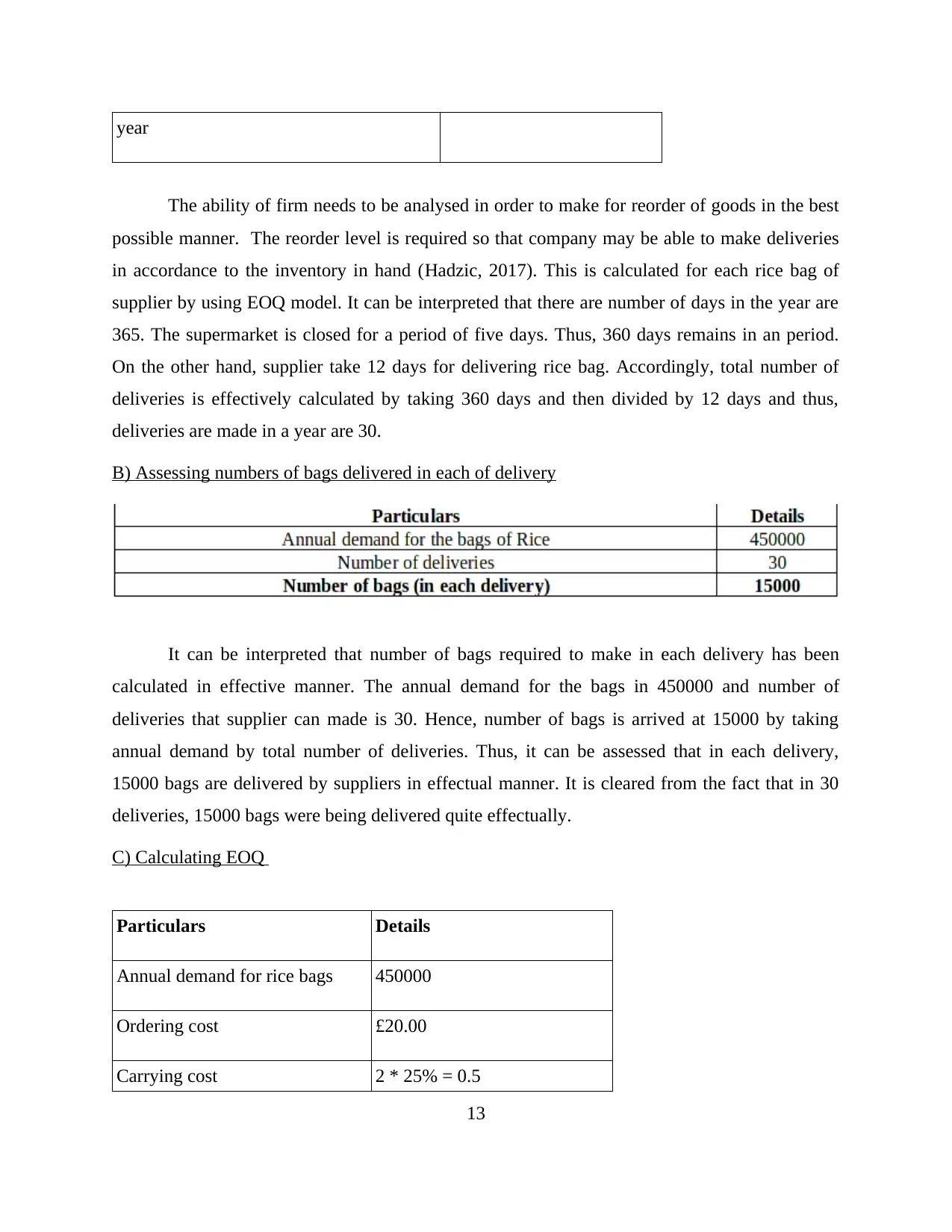
year
The ability of firm needs to be analysed in order to make for reorder of goods in the best
possible manner. The reorder level is required so that company may be able to make deliveries
in accordance to the inventory in hand (Hadzic, 2017). This is calculated for each rice bag of
supplier by using EOQ model. It can be interpreted that there are number of days in the year are
365. The supermarket is closed for a period of five days. Thus, 360 days remains in an period.
On the other hand, supplier take 12 days for delivering rice bag. Accordingly, total number of
deliveries is effectively calculated by taking 360 days and then divided by 12 days and thus,
deliveries are made in a year are 30.
B) Assessing numbers of bags delivered in each of delivery
It can be interpreted that number of bags required to make in each delivery has been
calculated in effective manner. The annual demand for the bags in 450000 and number of
deliveries that supplier can made is 30. Hence, number of bags is arrived at 15000 by taking
annual demand by total number of deliveries. Thus, it can be assessed that in each delivery,
15000 bags are delivered by suppliers in effectual manner. It is cleared from the fact that in 30
deliveries, 15000 bags were being delivered quite effectually.
C) Calculating EOQ
Particulars Details
Annual demand for rice bags 450000
Ordering cost £20.00
Carrying cost 2 * 25% = 0.5
13
The ability of firm needs to be analysed in order to make for reorder of goods in the best
possible manner. The reorder level is required so that company may be able to make deliveries
in accordance to the inventory in hand (Hadzic, 2017). This is calculated for each rice bag of
supplier by using EOQ model. It can be interpreted that there are number of days in the year are
365. The supermarket is closed for a period of five days. Thus, 360 days remains in an period.
On the other hand, supplier take 12 days for delivering rice bag. Accordingly, total number of
deliveries is effectively calculated by taking 360 days and then divided by 12 days and thus,
deliveries are made in a year are 30.
B) Assessing numbers of bags delivered in each of delivery
It can be interpreted that number of bags required to make in each delivery has been
calculated in effective manner. The annual demand for the bags in 450000 and number of
deliveries that supplier can made is 30. Hence, number of bags is arrived at 15000 by taking
annual demand by total number of deliveries. Thus, it can be assessed that in each delivery,
15000 bags are delivered by suppliers in effectual manner. It is cleared from the fact that in 30
deliveries, 15000 bags were being delivered quite effectually.
C) Calculating EOQ
Particulars Details
Annual demand for rice bags 450000
Ordering cost £20.00
Carrying cost 2 * 25% = 0.5
13
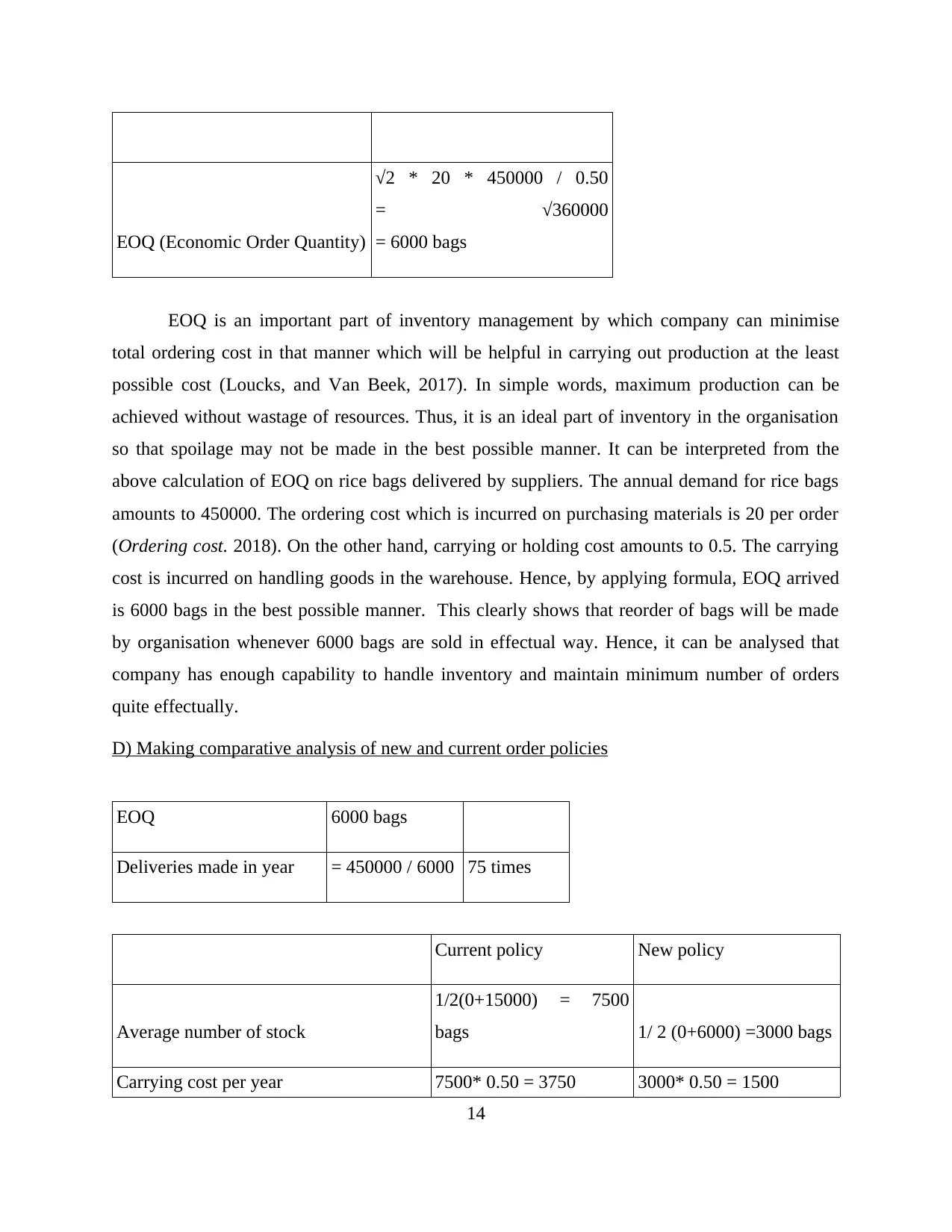
EOQ (Economic Order Quantity)
√2 * 20 * 450000 / 0.50
= √360000
= 6000 bags
EOQ is an important part of inventory management by which company can minimise
total ordering cost in that manner which will be helpful in carrying out production at the least
possible cost (Loucks, and Van Beek, 2017). In simple words, maximum production can be
achieved without wastage of resources. Thus, it is an ideal part of inventory in the organisation
so that spoilage may not be made in the best possible manner. It can be interpreted from the
above calculation of EOQ on rice bags delivered by suppliers. The annual demand for rice bags
amounts to 450000. The ordering cost which is incurred on purchasing materials is 20 per order
(Ordering cost. 2018). On the other hand, carrying or holding cost amounts to 0.5. The carrying
cost is incurred on handling goods in the warehouse. Hence, by applying formula, EOQ arrived
is 6000 bags in the best possible manner. This clearly shows that reorder of bags will be made
by organisation whenever 6000 bags are sold in effectual way. Hence, it can be analysed that
company has enough capability to handle inventory and maintain minimum number of orders
quite effectually.
D) Making comparative analysis of new and current order policies
EOQ 6000 bags
Deliveries made in year = 450000 / 6000 75 times
Current policy New policy
Average number of stock
1/2(0+15000) = 7500
bags 1/ 2 (0+6000) =3000 bags
Carrying cost per year 7500* 0.50 = 3750 3000* 0.50 = 1500
14
√2 * 20 * 450000 / 0.50
= √360000
= 6000 bags
EOQ is an important part of inventory management by which company can minimise
total ordering cost in that manner which will be helpful in carrying out production at the least
possible cost (Loucks, and Van Beek, 2017). In simple words, maximum production can be
achieved without wastage of resources. Thus, it is an ideal part of inventory in the organisation
so that spoilage may not be made in the best possible manner. It can be interpreted from the
above calculation of EOQ on rice bags delivered by suppliers. The annual demand for rice bags
amounts to 450000. The ordering cost which is incurred on purchasing materials is 20 per order
(Ordering cost. 2018). On the other hand, carrying or holding cost amounts to 0.5. The carrying
cost is incurred on handling goods in the warehouse. Hence, by applying formula, EOQ arrived
is 6000 bags in the best possible manner. This clearly shows that reorder of bags will be made
by organisation whenever 6000 bags are sold in effectual way. Hence, it can be analysed that
company has enough capability to handle inventory and maintain minimum number of orders
quite effectually.
D) Making comparative analysis of new and current order policies
EOQ 6000 bags
Deliveries made in year = 450000 / 6000 75 times
Current policy New policy
Average number of stock
1/2(0+15000) = 7500
bags 1/ 2 (0+6000) =3000 bags
Carrying cost per year 7500* 0.50 = 3750 3000* 0.50 = 1500
14
Secure Best Marks with AI Grader
Need help grading? Try our AI Grader for instant feedback on your assignments.
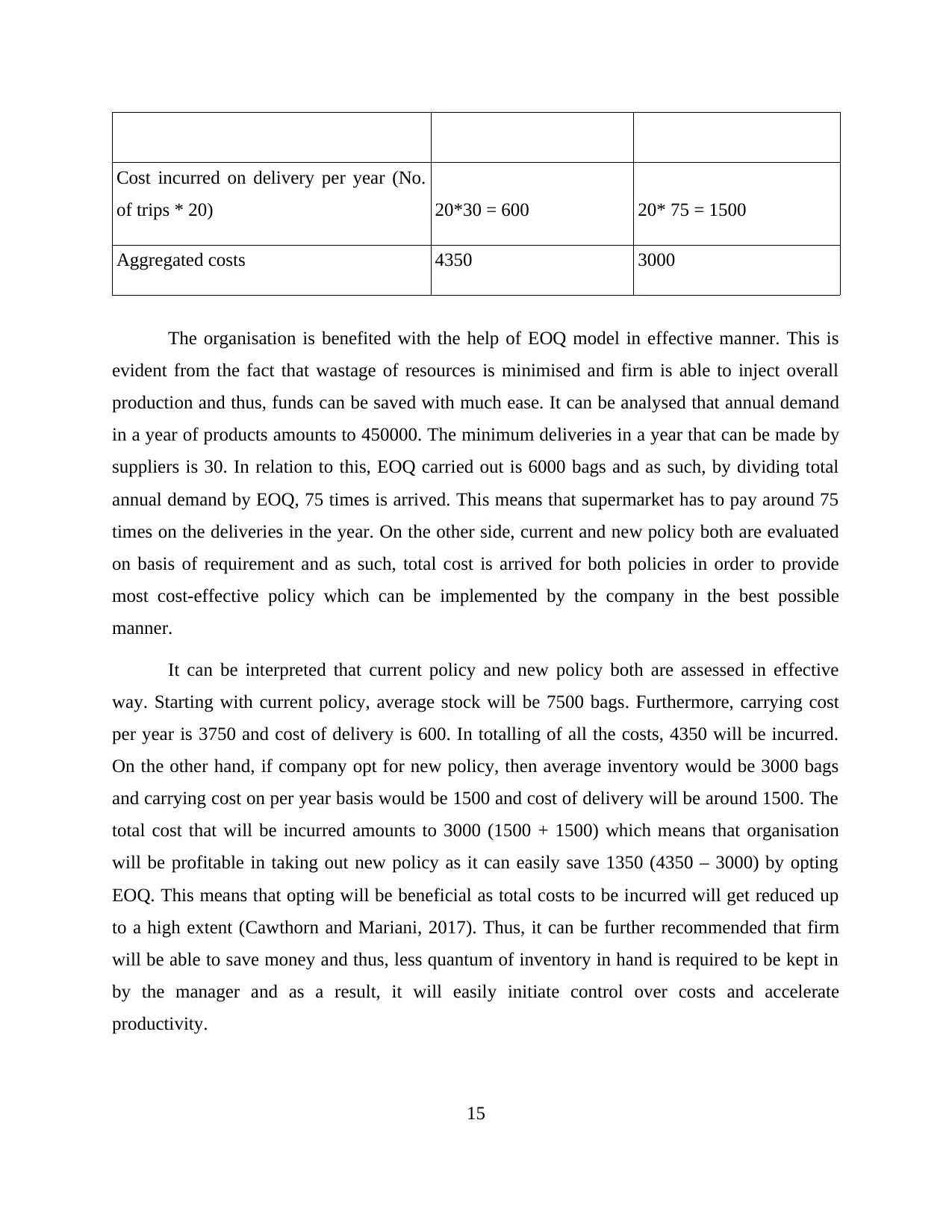
Cost incurred on delivery per year (No.
of trips * 20) 20*30 = 600 20* 75 = 1500
Aggregated costs 4350 3000
The organisation is benefited with the help of EOQ model in effective manner. This is
evident from the fact that wastage of resources is minimised and firm is able to inject overall
production and thus, funds can be saved with much ease. It can be analysed that annual demand
in a year of products amounts to 450000. The minimum deliveries in a year that can be made by
suppliers is 30. In relation to this, EOQ carried out is 6000 bags and as such, by dividing total
annual demand by EOQ, 75 times is arrived. This means that supermarket has to pay around 75
times on the deliveries in the year. On the other side, current and new policy both are evaluated
on basis of requirement and as such, total cost is arrived for both policies in order to provide
most cost-effective policy which can be implemented by the company in the best possible
manner.
It can be interpreted that current policy and new policy both are assessed in effective
way. Starting with current policy, average stock will be 7500 bags. Furthermore, carrying cost
per year is 3750 and cost of delivery is 600. In totalling of all the costs, 4350 will be incurred.
On the other hand, if company opt for new policy, then average inventory would be 3000 bags
and carrying cost on per year basis would be 1500 and cost of delivery will be around 1500. The
total cost that will be incurred amounts to 3000 (1500 + 1500) which means that organisation
will be profitable in taking out new policy as it can easily save 1350 (4350 – 3000) by opting
EOQ. This means that opting will be beneficial as total costs to be incurred will get reduced up
to a high extent (Cawthorn and Mariani, 2017). Thus, it can be further recommended that firm
will be able to save money and thus, less quantum of inventory in hand is required to be kept in
by the manager and as a result, it will easily initiate control over costs and accelerate
productivity.
15
of trips * 20) 20*30 = 600 20* 75 = 1500
Aggregated costs 4350 3000
The organisation is benefited with the help of EOQ model in effective manner. This is
evident from the fact that wastage of resources is minimised and firm is able to inject overall
production and thus, funds can be saved with much ease. It can be analysed that annual demand
in a year of products amounts to 450000. The minimum deliveries in a year that can be made by
suppliers is 30. In relation to this, EOQ carried out is 6000 bags and as such, by dividing total
annual demand by EOQ, 75 times is arrived. This means that supermarket has to pay around 75
times on the deliveries in the year. On the other side, current and new policy both are evaluated
on basis of requirement and as such, total cost is arrived for both policies in order to provide
most cost-effective policy which can be implemented by the company in the best possible
manner.
It can be interpreted that current policy and new policy both are assessed in effective
way. Starting with current policy, average stock will be 7500 bags. Furthermore, carrying cost
per year is 3750 and cost of delivery is 600. In totalling of all the costs, 4350 will be incurred.
On the other hand, if company opt for new policy, then average inventory would be 3000 bags
and carrying cost on per year basis would be 1500 and cost of delivery will be around 1500. The
total cost that will be incurred amounts to 3000 (1500 + 1500) which means that organisation
will be profitable in taking out new policy as it can easily save 1350 (4350 – 3000) by opting
EOQ. This means that opting will be beneficial as total costs to be incurred will get reduced up
to a high extent (Cawthorn and Mariani, 2017). Thus, it can be further recommended that firm
will be able to save money and thus, less quantum of inventory in hand is required to be kept in
by the manager and as a result, it will easily initiate control over costs and accelerate
productivity.
15

M3 Use of statistical methods and justification of techniques
The methods such as descriptive and data analysis both are used. Data analysis is useful
for transformation of data into effective information. While, sampling is another method used by
researcher in carrying out selected population out of the universe which is representative of
population.
Activity 4
A) Preparation of line chart by considering Activity 1
Gross annual earnings in private sector
2010 2011 2012 2013 2014 2015 2016
0
5000
10000
15000
20000
25000
30000
35000
40000
Male employees
Female employees
The above graph shows gross annual earnings attained by male and female sector. The
earnings of male in the private sector is more in comparison to female. It is clearly depicted from
the graph produced that salaries are paid in more quantum to male workforce (Khalil, Gupta and
Hanif, 2018). It is required that UK government should make plans to increase salaries of female
and women empowerment should be focused. This will bring more efficiency in overall
productivity of private sector.
Gross annual earnings in public sector
16
The methods such as descriptive and data analysis both are used. Data analysis is useful
for transformation of data into effective information. While, sampling is another method used by
researcher in carrying out selected population out of the universe which is representative of
population.
Activity 4
A) Preparation of line chart by considering Activity 1
Gross annual earnings in private sector
2010 2011 2012 2013 2014 2015 2016
0
5000
10000
15000
20000
25000
30000
35000
40000
Male employees
Female employees
The above graph shows gross annual earnings attained by male and female sector. The
earnings of male in the private sector is more in comparison to female. It is clearly depicted from
the graph produced that salaries are paid in more quantum to male workforce (Khalil, Gupta and
Hanif, 2018). It is required that UK government should make plans to increase salaries of female
and women empowerment should be focused. This will bring more efficiency in overall
productivity of private sector.
Gross annual earnings in public sector
16
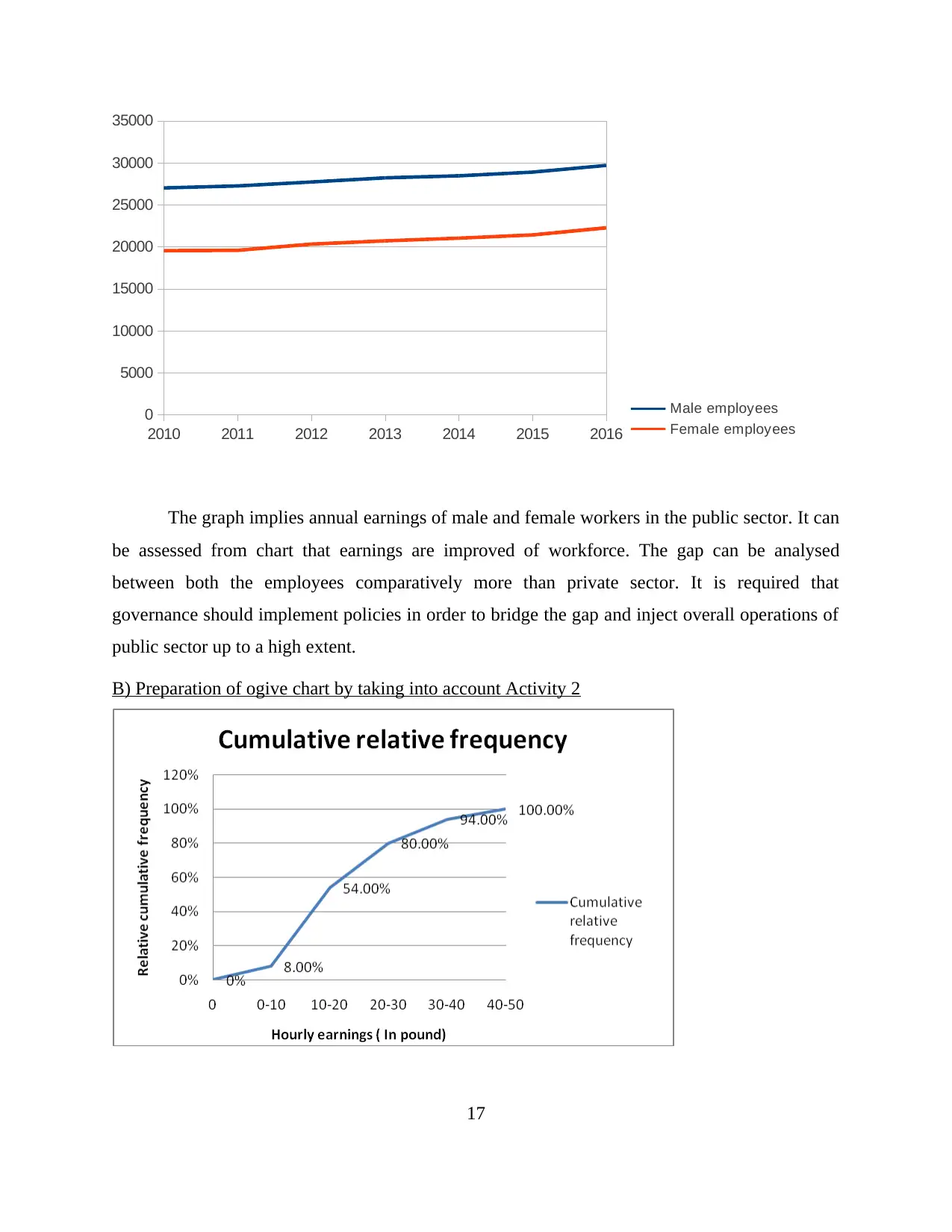
2010 2011 2012 2013 2014 2015 2016
0
5000
10000
15000
20000
25000
30000
35000
Male employees
Female employees
The graph implies annual earnings of male and female workers in the public sector. It can
be assessed from chart that earnings are improved of workforce. The gap can be analysed
between both the employees comparatively more than private sector. It is required that
governance should implement policies in order to bridge the gap and inject overall operations of
public sector up to a high extent.
B) Preparation of ogive chart by taking into account Activity 2
17
0
5000
10000
15000
20000
25000
30000
35000
Male employees
Female employees
The graph implies annual earnings of male and female workers in the public sector. It can
be assessed from chart that earnings are improved of workforce. The gap can be analysed
between both the employees comparatively more than private sector. It is required that
governance should implement policies in order to bridge the gap and inject overall operations of
public sector up to a high extent.
B) Preparation of ogive chart by taking into account Activity 2
17
Paraphrase This Document
Need a fresh take? Get an instant paraphrase of this document with our AI Paraphraser
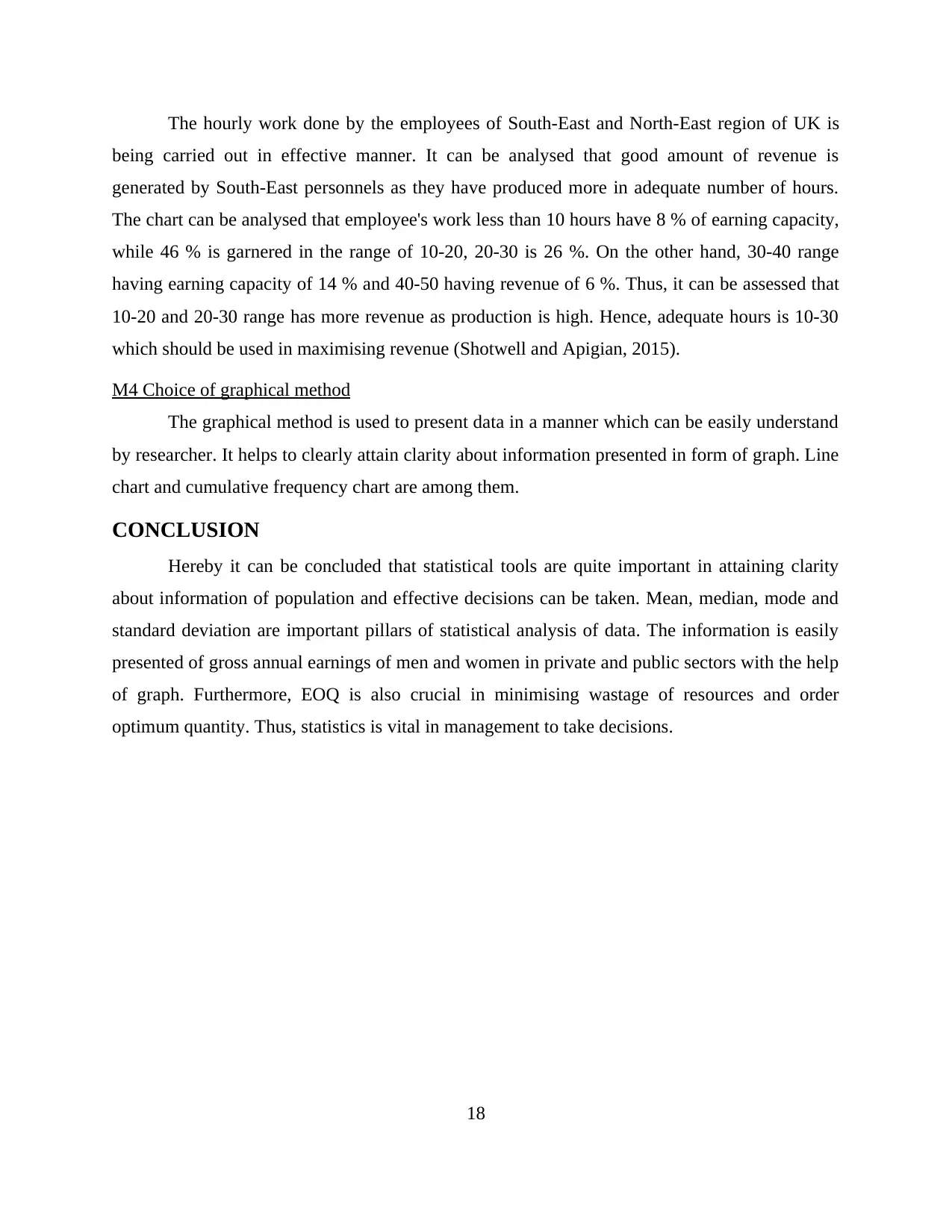
The hourly work done by the employees of South-East and North-East region of UK is
being carried out in effective manner. It can be analysed that good amount of revenue is
generated by South-East personnels as they have produced more in adequate number of hours.
The chart can be analysed that employee's work less than 10 hours have 8 % of earning capacity,
while 46 % is garnered in the range of 10-20, 20-30 is 26 %. On the other hand, 30-40 range
having earning capacity of 14 % and 40-50 having revenue of 6 %. Thus, it can be assessed that
10-20 and 20-30 range has more revenue as production is high. Hence, adequate hours is 10-30
which should be used in maximising revenue (Shotwell and Apigian, 2015).
M4 Choice of graphical method
The graphical method is used to present data in a manner which can be easily understand
by researcher. It helps to clearly attain clarity about information presented in form of graph. Line
chart and cumulative frequency chart are among them.
CONCLUSION
Hereby it can be concluded that statistical tools are quite important in attaining clarity
about information of population and effective decisions can be taken. Mean, median, mode and
standard deviation are important pillars of statistical analysis of data. The information is easily
presented of gross annual earnings of men and women in private and public sectors with the help
of graph. Furthermore, EOQ is also crucial in minimising wastage of resources and order
optimum quantity. Thus, statistics is vital in management to take decisions.
18
being carried out in effective manner. It can be analysed that good amount of revenue is
generated by South-East personnels as they have produced more in adequate number of hours.
The chart can be analysed that employee's work less than 10 hours have 8 % of earning capacity,
while 46 % is garnered in the range of 10-20, 20-30 is 26 %. On the other hand, 30-40 range
having earning capacity of 14 % and 40-50 having revenue of 6 %. Thus, it can be assessed that
10-20 and 20-30 range has more revenue as production is high. Hence, adequate hours is 10-30
which should be used in maximising revenue (Shotwell and Apigian, 2015).
M4 Choice of graphical method
The graphical method is used to present data in a manner which can be easily understand
by researcher. It helps to clearly attain clarity about information presented in form of graph. Line
chart and cumulative frequency chart are among them.
CONCLUSION
Hereby it can be concluded that statistical tools are quite important in attaining clarity
about information of population and effective decisions can be taken. Mean, median, mode and
standard deviation are important pillars of statistical analysis of data. The information is easily
presented of gross annual earnings of men and women in private and public sectors with the help
of graph. Furthermore, EOQ is also crucial in minimising wastage of resources and order
optimum quantity. Thus, statistics is vital in management to take decisions.
18
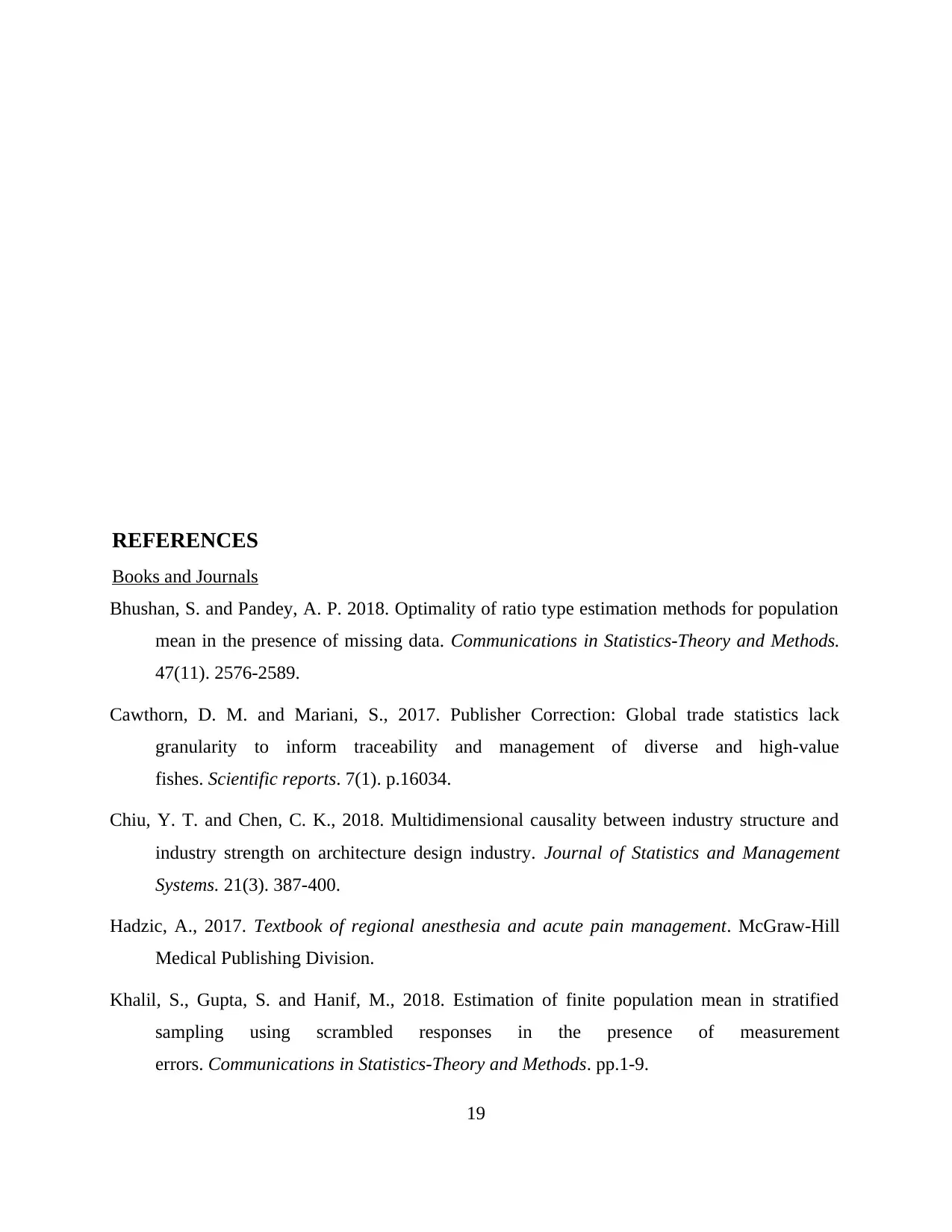
REFERENCES
Books and Journals
Bhushan, S. and Pandey, A. P. 2018. Optimality of ratio type estimation methods for population
mean in the presence of missing data. Communications in Statistics-Theory and Methods.
47(11). 2576-2589.
Cawthorn, D. M. and Mariani, S., 2017. Publisher Correction: Global trade statistics lack
granularity to inform traceability and management of diverse and high-value
fishes. Scientific reports. 7(1). p.16034.
Chiu, Y. T. and Chen, C. K., 2018. Multidimensional causality between industry structure and
industry strength on architecture design industry. Journal of Statistics and Management
Systems. 21(3). 387-400.
Hadzic, A., 2017. Textbook of regional anesthesia and acute pain management. McGraw-Hill
Medical Publishing Division.
Khalil, S., Gupta, S. and Hanif, M., 2018. Estimation of finite population mean in stratified
sampling using scrambled responses in the presence of measurement
errors. Communications in Statistics-Theory and Methods. pp.1-9.
19
Books and Journals
Bhushan, S. and Pandey, A. P. 2018. Optimality of ratio type estimation methods for population
mean in the presence of missing data. Communications in Statistics-Theory and Methods.
47(11). 2576-2589.
Cawthorn, D. M. and Mariani, S., 2017. Publisher Correction: Global trade statistics lack
granularity to inform traceability and management of diverse and high-value
fishes. Scientific reports. 7(1). p.16034.
Chiu, Y. T. and Chen, C. K., 2018. Multidimensional causality between industry structure and
industry strength on architecture design industry. Journal of Statistics and Management
Systems. 21(3). 387-400.
Hadzic, A., 2017. Textbook of regional anesthesia and acute pain management. McGraw-Hill
Medical Publishing Division.
Khalil, S., Gupta, S. and Hanif, M., 2018. Estimation of finite population mean in stratified
sampling using scrambled responses in the presence of measurement
errors. Communications in Statistics-Theory and Methods. pp.1-9.
19
1 out of 21
Related Documents
Your All-in-One AI-Powered Toolkit for Academic Success.
+13062052269
info@desklib.com
Available 24*7 on WhatsApp / Email
![[object Object]](/_next/static/media/star-bottom.7253800d.svg)
Unlock your academic potential
© 2024 | Zucol Services PVT LTD | All rights reserved.





